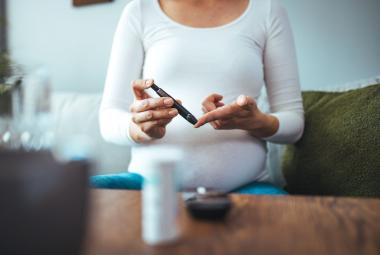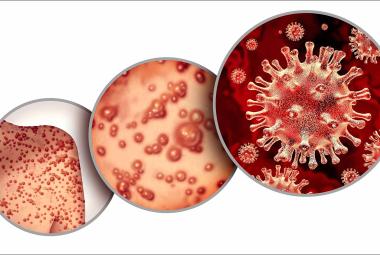Insect bites are certainly annoying, but they can also transmit disease. In the USA alone, insect bites can transmit Lyme disease, Rocky Mountain spotted fever, chikungunya, and dengue fever to name a few. Problems from these diseases produce a significant burden on the health care system in the United States even though insect bites might not be a part of everyone’s outdoor experience. In other parts of the world, malaria, Chaga’s disease, yellow fever, and many other diseases continue to be major killers. The species involved, specific diseases, and risk levels vary significantly by season and geography, but a few general principles still apply to assuring personal protection.
Biting insects like mosquitoes, ticks, and fleas tend to cause the most problems in terms of transmitting disease. Stinging insects like bees, wasps, ants, and flies can certainly cause severe allergic reactions and skin infections, but these problems are relatively rare in comparison. The products that are sold for personal protection from insects are mostly directed at the biting species.
Many people have strong feelings about using chemicals to kill or repel pests, especially when it comes to doing so around infants and pregnant women. Health and safety should be a high priority for everyone, so it pays to be knowledgeable about the options for staying safe outdoors. To start, here are some tips for avoiding insect bites without using chemicals:
· Wear long sleeved clothing tucked into socks or boots and pull long hair back into a hat. The clothes should be loose fitting because mosquitoes can bite through tights. During mosquito- or tick-heavy hours, put on long sleeves, long pants, socks, and closed-toe shoes.
· Use a fan. Mosquitoes are weak fliers and literally can be blown away by a moderate breeze.
· Use CO2-based mosquito traps to reduce the local population around your home.
· Encourage community-based mosquito-reduction programs.
· Install outdoor lighting that does not attract pests. Conventional bulbs emit some light in the ultraviolet range and insects tend to fly toward these lights. Look for bulbs with limited UV emissions.
· Don’t use bug zappers. The central component of a bug zapper is a light that is specifically designed to attract insects into the area.
· Seal windows and screens carefully.
· Avoid dawn and dusk when mosquitoes are most active. Keep doors, windows, and screens closed during this time.
· If biting insects are getting into the home despite your best efforts, consider using mosquito netting around the bed.
· Outside, a baby carrier draped in mosquito netting does a decent job of keeping insects away from the child inside.
· Don't use scented soaps, perfumes, or hair sprays. The odors attract insects.
· Avoid dressing in bright colors or flowery prints.
· Avoid areas where insects nest or congregate, such as stagnant pools of water, uncovered foods, and gardens where flowers are in bloom.
· Drain areas with stagnant pools of water, such as water dishes, and other areas that may accumulate water over time.
· Maintain adequate landscaping to prevent the growth and accumulation of insects.
· Perform tick checks in clothes, pets, tools, and outdoor equipment. Light-colored clothes can help in seeing ticks more easily.
· Aggressively control fleas on pets whenever possible.
There are lots of different chemical insect repellent brands on the market, but only a handful of unique ingredients in them. There are pluses and minuses for each substance and one substance may not be appropriate for every situation. Read up on each ingredient in this chart and decide what’s right for you.
James Abbey, MD
Saneea Almas, MD
InfantRisk Center
Table 1. Natural and Chemical Insect Repellents
DEET
(N,N-diethyl-m-toluamide)
Does it work?
DEET is one of the most effective tick and mosquito repellents on the market. Increasing concentrations of DEET result in longer duration of protection without reapplication. 5% lasts about 2 hours, 15% for 6 hours, 30-50% for 8 hours.1No additional benefit is seen with concentrations >50%.2
Is it safe…
for adults?
DEET has been used and studied in the United States since 1957. The EPA and FDA consider DEET to be safe, provided that the user follows instructions for proper use. By law, these instructions must be printed on the label of every DEET-containing product marketed in the US.3, 4In addition, the CDC recommends applying DEET over/after sunscreen and not using DEET + sunscreen combination products at all.5There have been isolated cases of contact dermatitis from DEET use.5Severe toxicity, including seizures and coma, is associated with improper use such as ingestion.3Minimize exposure by selecting a DEET concentration appropriate for the duration of outdoor activity.
for pregnancy?
Animal studies, using doses 10-100 times higher than proportional human doses, have failed to show any increased risk of birth defects from transdermal DEET exposure. Low birth weight was seen in animals with the highest doses.2A study of DEET safety in the second and third trimester demonstrated no increased risk of birth defects or adverse neurobehavioral outcomes in humans.6No studies of DEET exposure in the first trimester have been published.
for breastfeeding?
No studies on the transfer of DEET into human milk are available. Because it is lipophilic, some of it may transfer into breastmilk. 5-15% of DEET applied to the skin is absorbed, but plasma levels are undetectable as early as 4 hours after application.7Breastfeeding cessation during this period is a reasonable precaution to minimize risk. As with all topical medications, avoid exposing the infant to residues on the hands, breasts, or clothing.
for children?
The AAP advises not using insect repellents of any kind on babies <2 months. A child carrier draped in mosquito netting is an effective alternative. For older children, follow the printed safety instructions on the label. Despite extensive use, fewer than 20 cases of DEET-related encephalopathy have ever been reported in children following dermal application. Limit DEET concentrations to <31% in children and consider alternatives if daily application is indicated.8
for the environment?
The EPA conducted a review of DEET environmental safety data in 2014. Their interim assessment was that “no risks of concern were identified” and they “made a ‘no effect’ determination for federally listed species and designated critical habitat.”9DEET is still being evaluated by an EPA sub-division called the Endocrine Disruptor Screening Program. The EPA’s statement will be revised when the EDSP evaluation is complete.
Permethrin
Does it work?
Permethrin is highly effective as a mosquito, fly, and tick repellent when incorporated into cloth and other inorganic surfaces. It is routinely used in camping equipment, military uniforms, and mosquito netting. The WHO estimates that using nets coated with this and similar insecticides is responsible for a 60-80% reduction in 3rd world malaria cases as compared with nets alone.10The use of permethrin as a topical insecticide for lice and scabies is discussed separately [link to InfantRisk article on lice]. The use of permethrin in residential applications, community pest control, and agricultural sprays is not discussed here.
Is it safe…
for adults?
The EPA cites animal studies suggesting that ingested or transdermally absorbed permethrin is “probably carcinogenic”, although this data is weak. However, the exposure via wearing impregnated clothing is thought to be negligible. The EPA stated that they have no concerns about cancer or non-cancer scenarios related to permethrin used as a cloth impregnant.11
for pregnancy?
Permethrin has been demonstrated to cross the placenta. However, absorption from treated clothing is less than 1/1000 of that from topical permethrin lotions used for lice [link].11The topical formulation is FDA pregnancy category B.
for breastfeeding?
Permethrin has been detected in breastmilk, but levels are exceedingly low. Absorption from treated clothing is negligible.11The breastfed infant is unlikely to be exposed to clinically relevant amounts through the breastmilk.
for children?
Topical permethrin lotions can be used safely in neonates <1 month old.12Since exposure from treated clothing and surfaces is so much less than direct topical application, it is probably quite safe for children of all ages.
for the environment?
Environmental impact from cloth impregnated with permethrin is minimal. However, large-scale spraying represents considerable risk to aquatic organisms, bees, and beneficial insects.11
Lemon Eucalyptus
(P-menthane-3,8-diol or Citriodiol)
Does it work?
Yes. Lemon Eucalyptus is a plant-derived essential oil. Concentrations around 40% appear to be as effective as 20% DEET in preventing mosquito bites.13, 14This needs to be applied more frequently than DEET, at least every 5 hours. Specific formulations are effective at repelling ticks, but less so than DEET.15
Is it safe…
for adults?
Eye irritation has been reported as a side effect. Product packaging should advise applying in a well-ventilated area and avoiding exposure to the face.
for pregnancy?
There are no specific studies examining this product in pregnant women. Other substances have substantial data published supporting their safe use in this population. Lemon eucalyptus oil should not be a pregnant woman’s first choice of insect repellent.
for breastfeeding?
Not enough is known about eucalyptus oil’s safety for breastfeeding. It is unlikely that this oil would be absorbed in significant quantities or get into the breastmilk. However, it almost certainly remains on the skin surface until it is deliberately washed off. As with all topical medications, avoid exposing the infant to residues on the hands, breasts, or clothing.
for children?
This product is not appropriate for children younger than 3 years, mostly because of the risk of eye irritation. Children this age are more likely to touch their faces, wipe their eyes, or lick their skin.
for the environment?
This chemical has low toxicity and is generally only used in small quantities. Laboratory studies on animals suggest it poses virtually no risk to wildlife.16
Picaridin
Does it work?
Yes. Picaridin is a synthetic compound based on natural oils found in pepper. On the skin or clothing, it has been shown both to repel insects discourage them from biting treated skin.17It provides reasonable protection for up to 8 hours. Different formulations are available for treating fabric, skin, and building surfaces. No increase in efficacy has been demonstrated above 20% concentration.
Is it safe…
for adults?
It is practically non-toxic if inhaled, but can be poisonous with modest oral ingestion. Rashes, eye irritation, and allergic reactions have been reported with routine use. The EPA has classified this chemical as NOT a carcinogen in humans.18
for pregnancy?
Animal studies have shown no toxic effects to fetuses of animals exposed to picaridin. At this time, there have been no reports on humans.
for breastfeeding?
Picaridin does not adversely affect breastfeeding when used with the guidelines established on the label of the product. As with all topical medications, avoid exposing the infant to residues on the hands, breasts, or clothing.
for children?
This product is not appropriate for children younger than 3 years, mostly because of the risk of eye irritation. Children this age are more likely to touch their faces, wipe their eyes, or lick their skin.
for the environment?
Picaridin does not harm the environment with routine use. Avoid disposing of large amounts near fish.18
IR3535
Does it work?
Ethyl butylacetylaminoproprionate is an insect repellant also known as IR3535. It is as effective as DEET in repelling mosquitoes, ticks, and flies. The manufacturer suggests this product provided 8 hours of protection, but market testing has shown that more frequent re-application may be necessary for complete protection.19
Is it safe…
for adults?
Eye irritation has been reported as a side effect. Product packaging should advise applying in a well-ventilated area and avoiding exposure to the face.
for pregnancy?
There are no specific studies examining this product in pregnant women. Other substances have substantial data published supporting their safe use in this population. IR3535 should not be a pregnant woman’s first choice of insect repellent.
for breastfeeding?
Not enough is known about IR3535’s safety for breastfeeding. It is unlikely that this substance would be absorbed in significant quantities or get into the breastmilk. However, it almost certainly remains on the skin surface until it is deliberately washed off. As with all topical medications, avoid exposing the infant to residues on the hands, breasts, or clothing.
for children?
The AAP advises not using insect repellents of any kind on babies <2 months. A child carrier draped in mosquito netting is an effective alternative. The WHO has given it an excellent safety rating and the French ministry of health recommends IR3535 as insect repellant of choice in older children. In general, the EPA considers it very safe.
for the environment?
No harmful affects to the environment are reported with IR3535. It is currently not considered carcinogenic.
Natural plant oils (soybean, lemongrass, citronella, peppermint, lavender, geranium, or geranoil)
Does it work?
The natural plant oils are not as effective as commercially available conventional repellants. However, they provide do 30 minutes to 2 hours of protection against mosquitoes. These products would be appropriate for short-duration use in areas that are relatively low risk for insect-borne diseases.
Is it safe…
for adults?
Natural plant oils are considered safe for adults when used according to product labels.
for pregnancy?
These oils are considered safe in pregnant women when used according to product label guidelines.
for breastfeeding?
There is no data about safety of the oils in breastfeeding. Current recommendations suggest their use is safe when used as suggested.
for children?
The AAP advises not using insect repellents of any kind on babies <2 months. A child carrier draped in mosquito netting is an effective alternative. For older children, follow the printed safety instructions on the label.
for the environment?
These oils present minimal risk of harmful to the environment.
Metofluthrin
Does it work?
Metofluthrin is a commercial insect repellant that is not used on skin. A strip or cartridge that contains metofluthrin can be applied to surfaces (one week protection) or distributed by a small fan from a belt pack (12 hours protection).
Is it safe…
for adults?
Metofluthrin is approved for use in adults. Although it is a neurotoxic agent in rats, rabbits, and dogs, human side effects only include mild skin irritation and allergic reactions. Liver adenomas were also found in rats exposed to metofluthrin. Metofluthrin is likely to be a human carcinogen based on hepatocellular adenomas and carcinomas in rat studies. This carcinogenic effect is likely to be seen assuming the product is used 12 times a year for 50 years.
for pregnancy?
Animal studies have shown no adverse effects to the fetus in pregnant animals. Maternal toxicity is well documented in rats and rabbits leading to no developmental toxicity. There have been no human studies conducted.
for breastfeeding?
Metofluthrin is only approved for residential use at this time. There are no oral or dermal uses available and no good data on how much of this drug might be absorbed by a breastfeeding woman.
for children?
As approved for residential use, there are no guidelines for children. It appears to be safe when used according to the label on the products.
for the environment?
Metofluthrin is not known to be toxic to mammals or birds but exhibited extreme toxicity to aquatic animals and non-nuisance insects.20Use in moderation.
Oral Vitamin B1
Does it work?
However, current data suggests that it is not an effective alternative to commercial insect repellants.21
Is it safe…
for adults?
Vitamin B1 is safe to use when taken in recommended daily allowances.
for pregnancy?
Vitamin B1 is safe in pregnant women when taken in recommended daily allowances.
for breastfeeding?
Vitamin B1 is safe in breastfeeding women when taken in recommended daily allowances.
for children?
As a normal part of any healthy diet and a recommended vitamin, it is safe in children.
for the environment?
Vitamin B1 is safe for the environment.
Oral Garlic
Does it work?
Garlic in crushed or raw form has been used as a homemade remedy for insect repellence. Current evidence suggests that it does not work any better than placebo in repelling insects.22
Is it safe…
for adults?
As part of various foods, garlic is safe for use in adults in recommended doses.
for pregnancy?
Garlic is a safe product for pregnant women.
for breastfeeding?
Garlic is safe for breastfeeding women in moderation. High-dose exposure can change the taste of breastmilk and may make the baby reluctant to feed.
for children?
Garlic is a safe ingredient of many foods.
for the environment?
Garlic is safe for the environment.
Copyright InfantRisk Center 2015 (C)
James Abbey, MD
Saneea Almas, MD
InfantRisk Center
References:
1. Best way to stop bug bites. Consumer Reports. Available at: http://www.consumerreports.org/cro/2014/05/best-way-to-stop-bug-bites/index.htm, 2014.
2. Koren G, Matsui D, Bailey B. DEET-based insect repellents: safety implications for children and pregnant and lactating women. CMAJ : Canadian Medical Association journal = journal de l'Association medicale canadienne. Aug 5 2003;169(3):209-212
3. Safety Review of DEET. Environmental Protection Agency. Available at: http://www2.epa.gov/insect-repellents/deet - safety, 2014.
4. Insect Repellant Use and Safety in Children. Food and Drug Aministration. Available at: http://www.fda.gov/Drugs/EmergencyPreparedness/ucm085277.htm, 2014.
5. Nasci RS, Zielinski-Gutierrez E, Wirtz RA, Brogdon WG. Protection against Mosquitoes, Ticks, & Other Insects & Arthropods: Repellents and Sunscreen. Centers for Disease Control and Prevention. Available at: http://wwwnc.cdc.gov/travel/yellowbook/2014/chapter-2-the-pre-travel-consultation/protection-against-mosquitoes-ticks-and-other-insects-and-arthropods, 2014.
6. McGready R, Hamilton KA, Simpson JA, et al. Safety of the insect repellent N,N-diethyl-M-toluamide (DEET) in pregnancy. The American journal of tropical medicine and hygiene. Oct 2001;65(4):285-289
7. Sudakin DL, Trevathan WR. DEET: a review and update of safety and risk in the general population. Journal of toxicology. Clinical toxicology. 2003;41(6):831-839
8. Red Book®: 2012 Report of the Committee on Infectious Diseases. 29th ed: American Academy of Pediatrics-Committee on Infectious Diseases; 2012.
9. Keigwin RP. Registration Review Final and Interim Decisions: Environmental Protection Agency; 2014.
10. Insecticide-Treated Mosquito Net Interventions: World Health Organization; 2003.
11. Permethrin Facts. EPA 738-F-09-001 ed: Environmental Protection Agency; 2009.
12. Tschudy MM, Arcara KM, Johns Hopkins Hospital. Children's Medical and Surgical Center. The Harriet Lane handbook : a manual for pediatric house officers. 19th ed. Philadelphia, PA: Mosby Elsevier; 2012.
13. Hadis M, Lulu M, Mekonnen Y, Asfaw T. Field trials on the repellent activity of four plant products against mainly Mansonia population in western Ethiopia. Phytotherapy research : PTR. Mar 2003;17(3):202-205
14. Barnard DR, Bernier UR, Posey KH, Xue RD. Repellency of IR3535, KBR3023, para-menthane-3,8-diol, and deet to black salt marsh mosquitoes (Diptera: Culicidae) in the Everglades National Park. Journal of medical entomology. Nov 2002;39(6):895-899
15. Gardulf A, Wohlfart I, Gustafson R. A prospective cross-over field trial shows protection of lemon eucalyptus extract against tick bites. Journal of medical entomology. Nov 2004;41(6):1064-1067
16. p-Menthane-3,8-diol (011550) Fact Sheet. Environmental Protection Agency; 2000.
17. Klun JA, Khrimian A, Debboun M. Repellent and deterrent effects of SS220, Picaridin, and Deet suppress human blood feeding by Aedes aegypti, Anopheles stephensi, and Phlebotomus papatasi. Journal of medical entomology. Jan 2006;43(1):34-39
18. Picaridin-New Pesticide Fact Sheet. Environmental Protection Agency; 2005.
19. IR3535. Available at: http://www.ir3535.com/en/effectiveness_of_ir3535/effectiveness_of_ir3535.html, 2015.
20. Metofluthrin - Pesticide Fact Sheet. Environmental Protection Agency; 2006.
21. Ives AR, Paskewitz SM, Inter L, S, Biology Interest G, Entomology C. Testing vitamin B as a home remedy against mosquitoes. Journal of the American Mosquito Control Association. Jun 2005;21(2):213-217
22. Rajan TV, Hein M, Porte P, Wikel S. A double-blinded, placebo-controlled trial of garlic as a mosquito repellant: a preliminary study. Medical and veterinary entomology. Mar 2005;19(1):84-89







